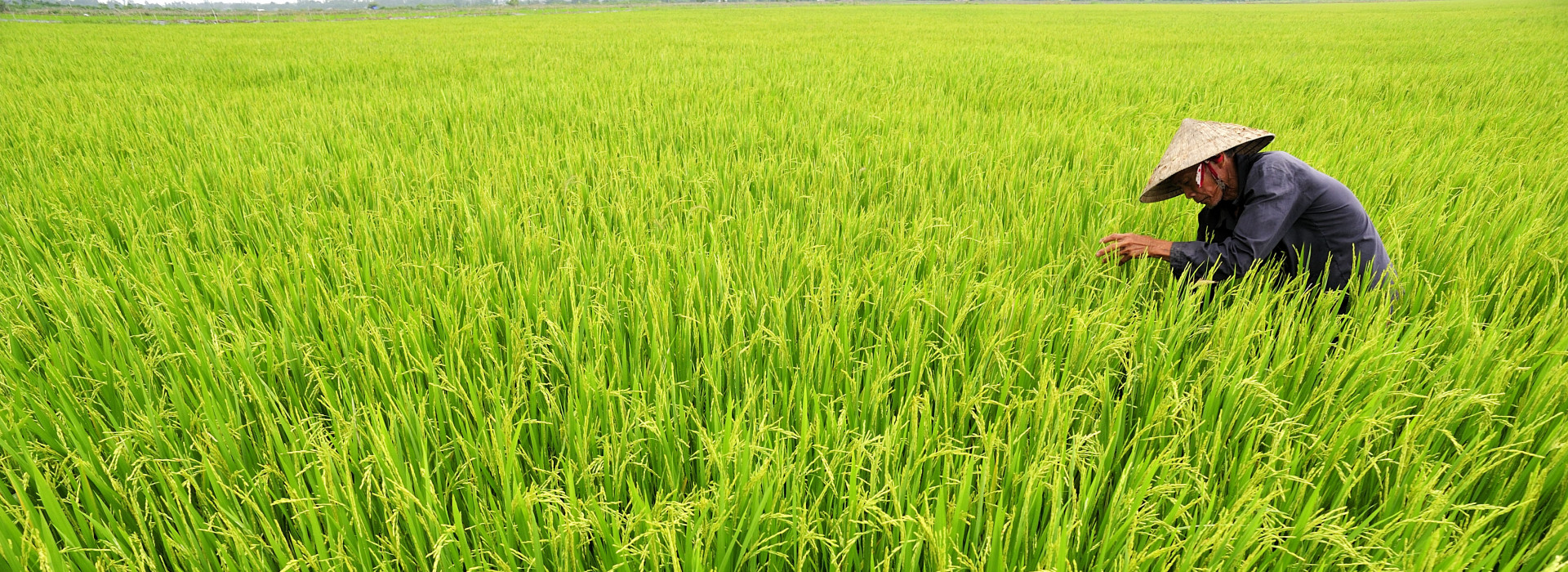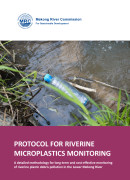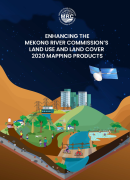
Agriculture and Irrigation
Agriculture is a cornerstone of economic growth in the Lower Mekong River Basin (LMB), providing livelihoods for more than 65 million people in the basin. Farming is the primary occupation of the rural areas of each lower Mekong country. Between 2011 and 2014, the numbers of people engaged in farming have increased in Cambodia, Thailand and Viet Nam by an average 9 percent to 6.9 million, whereas the total number of farmers in Lao PDR has appeared to decline from 238,000 to a little over 15,000. The most important secondary occupation is farm labour which had apparently increased by almost 500 percent between 2011 and 2014 to 18.6 million. These confirm the importance of the agricultural sector in generating household income.
More than 10 million hectares of agricultural land in the LMB is used for rice production, amounting to more than 80 percent of agricultural production. Irrigation water-use accounts for more than 70 percent of current utilisation, with 12 percent of the total annual flow is diverted for agriculture in the basin. Thailand and Viet Nam are home to intensive and diversified production of rice and other crops whereas agriculture in Cambodia and Lao PDR is currently less intensively developed.
The four countries are planning to further increase rice production and exports, respond to food security needs, and address rural poverty through crop diversification, promotion of commercial production and agro-industries, and expansion of irrigation areas.
According to the macroeconomic assessment report of the MRC Council Study, the net preserve value (NPV) of the agriculture sector LMB-wide is expected to increase by $104 billion by 2040 from $358 billion in 2017. The majority of this potential is linked to expansion plans in Cambodia ($67 billion), followed by Viet Nam ($26 billion). This reflects the greater role that efficient irrigation systems and techniques have played in increasing agricultural yields and production. The report estimates that the total irrigation area could nearly double, reaching 7 million hectares by 2040.
The benefits, however, come with costs. During the past decades, agricultural land in the LMB has been changed with the following trends: (i) some areas have become cultivation land from deforestation; (ii) due to improvement of irrigation, technology and market orientation, farmers have changed crops and crop pattern, resulting in increased crop production from one to two crops per year in some areas; (iii) agriculture land is degraded, forcing farmers to leave the land fallow; and (iv) agricultural land has been changed into other use purposes, including for hydropower projects and industrial zones.
These changes have negative impacts at multi levels of the basin. Firstly, they lead to change in water allocation for agriculture itself and for other purposes. In addition, deforestation, commercial concession plantations and mining developments contributed to changing land use will have transboundary impacts on hydrology progress and sediment transportation. Other important sectors such as the fisheries and navigation will also be affected. Land use change therefore needs to be monitored to understand its implications especially for upstream watershed management and on downstream water availability and quality.
In response to the challenging situation, the Mekong River Commission (MRC) focuses on fostering regional cooperation to accelerate the understanding and evaluation of the effects of development activities across the basin of medium- and long-term development planning by the MRC Member Countries. The MRC supports the countries through:
- Basin-wide strategies such as the Basin Development Strategy that seeks to reduce knowledge gaps and minimise risks from agriculture and water infrastructure development and improve national water resources development and management.
- Technical guidelines such as the guidelines for fish-friendly irrigation schemes that seek to improve fish populations through identification of fish passage barriers and improved design and construction of fish ladders attached to water structures such as dams, dikes or weirs.
- Studies and assessments that support planning and decision making.
- Capacity development that helps irrigation and agriculture planners and practitioners integrate basin-wide water resources planning to national agricultural sector and address transboundary issues.
In the past, agriculture was not a priority sector at the MRC. Previous MRC's work focused on providing information for development scenarios through data collection and analysis, and improving water use efficiency and catchment management through pilot projects formulated under the Agriculture, Irrigation and Forestry Programme (AIFP).
The AIFP promoted sound watershed management, produced guidelines for improving irrigation efficiency in paddy fields, improved irrigation and water-use methods, and enhanced methods for monitoring land-use changes.
The Member Countries also benefited from improved knowledge on irrigation modernisation, including water control methods, irrigation efficiency and productivity, flood mitigation, soil conservation and erosion control, and nurturing aquatic ecosystems.
Although the AIFP was valued by the Member Countries, it lacked a strategic coherence to inform basin-level planning and management. Therefore, under the Strategic Plan 2011-2015, the MRC shifted focus towards strategic and policy-based advice, guidance, and analysis in support of sustainable development and management from a basin-wide perspective. Much of the work was carried out by the Agriculture and Irrigation Programme (AIP), one of the 12 MRC programmes implemented during the five-year period.
The programme supported the integration of IWRM practices in national agricultural planning processes with a focus on agricultural water development in the Lower Mekong River Basin (LMB), addressed land and water-use issues in the agricultural sector to promote basin development, and played an important role in providing technical support in the area of irrigation development.
At country-level, the AIP helped improve crop production by promoting efficient practices in irrigated agriculture focusing on water allocation and distribution. In preparation for natural events that impact farmers’ livelihoods such as climate change, extreme floods and droughts, the programme relayed real-time flood and drought monitoring conditions to local and national agencies in order to better prepare communities for emergency situations.
At a broader level, the programme enhanced dialogue and coordination between countries in the basin and other stakeholders, such as civil society organisations and the private sector, on development-scenario modelling of agriculture, forestry and land-use change aspects, and responses to climate change with an emphasis on improving livelihoods for the poor.
The MRC’s support through the AIFP and AIP have accumulated significant information about irrigation systems, combined agriculture and aquaculture systems, and to a lesser extent, land-use. However, considerable work still needs to be done to improve agricultural knowledge, including on monitoring and assessment of land-use change, irrigation development, and changing patterns of flood and drought in agricultural areas.
Under the Basin Development Strategy (BDS) 2016-2020, of which strategic actions will be implemented through the MRC Strategic Plan (SP) 2016-2020, the MRC helped the Member Countries to:
- Reduce remaining knowledge gaps to minimise risks, including conducting study on the use of surface and groundwater, explore the potential for increased use of groundwater in agriculture, and provide guidance for sustainable groundwater use for crop production;
- Improve national water resources development and management, such as consolidating and implementing guidelines for design and operation of irrigation systems, including fish-friendly irrigation schemes; and
- Enhance information management, communications and tools, such as improvement of data, information, and knowledge management, and the irrigation database.
Other support includes predicting and monitoring water demand, understanding and predicting changes in water supply patterns and water levels, and monitoring and maintaining water quality in the LMB.
Through the new strategic cycle, the BDS 2021-2030 and MRC SP 2021-2025, the Member Countries will see the MRC’s assistance in improving irrigation structures to promote fish reproduction, such as the installation of fishway and examination of unused irrigation schemes which affect fish migration. For the agriculture, the MRC will support the development of guidelines for transboundary groundwater management, identification of irrigation development opportunities to support food security, including through climate smart agriculture and a transition to higher value agriculture products.
In light of the problems and constraints in agricultural water use, it is pivotal for the lower Mekong countries to increase the stock of knowledge to devise new approaches for the sustainable development of agricultural and water resource sectors.
Guided by the three strategic priorities highlighted above, the MRC has conducted a range of studies to increase evidence and knowledge on transboundary water impacts, sustainable groundwater use and management for agriculture, and agricultural land-use monitoring. A number of recent studies are highlighted below:
- Basin-wide development and climate change scenarios: The study, conducted from 2015-2017, assesses the impact of climate change on food security and outlined climate change adaptation options in vulnerable areas and communities, such as the modernisation of irrigation systems, improvement of soil and water conservation methods, fishery and irrigation management, and providing insurance for flood and drought loss. The findings and recommendations were used to inform the Mekong Adaptation Strategy and Action Plan (MASAP) and the MRC Status Report on Climate Change and Adaptation in the LMB.
- The Council Study: Irrigation and agriculture land-use change sectors: Irrigation and agriculture land-use change are two of the six thematic sectors featured in the Council Study. The study, which was completed in 2017, generates a number of findings:
- Excessive investment in hydropower and labour-intensive agriculture is likely to reduce both food security and GDP growth in the LMB. The planned expansion of traditional agricultural activities is likely to increase demand for labour at the same time as the manufacturing and service sectors expand. Over-investment in agriculture also raises the prospect of under-used or abandoned infrastructure.
- Over-investment in agriculture and hydropower accompanied by more severe climate change could compromise prospects for LMB countries to sustain lower-middle income or lower-middle-income status.
- Expanding farmlands and increasing irrigation capacity would make agricultural production more reliable but would come at the cost of accelerated soil erosion, increased use of agrochemicals, and land degradation.
- Irrigation efficiency in the lower basin needs to be improved. Sustainable irrigation requires reducing water-delivery losses, enlarging storage capacity, rehabilitating old irrigation facilities, and strengthening the capacity of farmers to manage the facilities.
The findings are expected to inform the preparation and development of national policy and planning by the Member Countries, and further enhance the MRC's support.
- Agricultural land-use monitoring in the pilot areas: The ongoing study aims to review and update the MRC’s existing land-use maps in selected sectors, conduct change detection, analyse the driving forces and impacts of major agricultural land-use changes on local people’s livelihoods, and provide recommendations on agricultural land-use management. The National Working Groups are finalising the study. Recommendations will be applied to future studies on agricultural land-use monitoring for the LMB.
- Study on sustainable groundwater use and management for agriculture: The study is being carried out to assess the current situation and future trends of groundwater discharge and recharge, as well as water quality in the LMB. The study will also evaluate the sustainability of current groundwater-use and agricultural development plans to utilise groundwater. A roadmap and an action plan for the management of transboundary groundwater for sustainable crop production will be developed.
As a complement to the studies and the strategies for agricultural and irrigation development, the MRC has developed the following guidelines and tools for the Member Countries to advance sustainable development of the agricultural and irrigation sectors in the LMB.
- Irrigation database improvement: The improvement of the MRC Irrigation Database is a high priority activity proposed by the former AIP. Completed in 2018, the activity has helped update the basic information on individual irrigation systems into a GIS facility for better-informed irrigation planning. This provides easy access to information on actual irrigable areas, maximum irrigated rice plantation areas, and total capacity of reservoirs, etc. The improved database is archived in the MRC Information System (MRC-IS) and available on the MRC Data Portal.
- Guidelines for fish-friendly irrigation schemes: In 2014, the MRC developed guidelines on ‘Prioritizing Fish Passage Barriers and Creating Fish-Friendly Irrigation Structures’ based on literature review and international experience. The guidelines outline methods for identifying barriers to fish migration, and the processes for the design, construction and maintenance of fish passages. The MRC, in collaboration with the U.S. Department of the Interior (DOI) and the Australian Center for International Agricultural Research (ACIAR), is now testing the guidelines to assess their effectiveness and identify areas for improvement. Inputs will be used to revise the guidelines and develop an action plan for promoting fish passage installation in the LMB.
The MRC has produced a series of knowledge products to facilitate decision-making and stimulate innovations for sustainable development of the agricultural and irrigation sectors, including strategies, guidelines and studies mentioned above.


